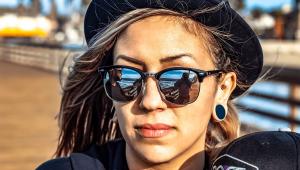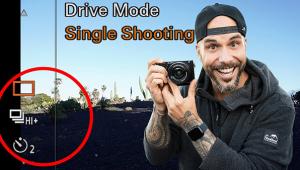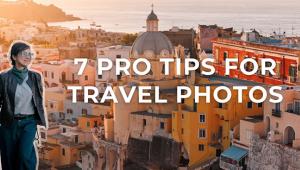Q&A: Pro Photographer & Photoshop Expert Scott Kelby Answers Your Photo Questions

Q. You mentioned the Canon 5D Mark III and its full-frame shooting capabilities in the June 2017 issue. I own a 5D Mark III and have noticed that when printing some of the photo is cropped, depending on the size (such as 11x14). I have printed at home and used print labs, and there is always a portion of the photo that is cropped. Is there a formula for getting the whole photo printed—either how the photo is shot, camera settings, software, etc.?
A. For reasons I lay awake and wonder at night, the printing and framing industry still seems to think we’re all using old film cameras, so they still rely on sizes from the old film days. Go to Target or Walmart and look at all the frame sizes on their shelves: they’re still 8x10 and 11x14 inches, and those sizes don’t work for the aspect ratios created by most digital cameras, so we wind up having to crop them to fit on those outdated paper sizes. Ugh! Luckily today’s photo labs are offering digital sizes, so instead of an 8x10, you’d print on 9x12-inch paper, which fits the aspect ratio of a digital image. Instead of an 11x14-inch print, you’d make a 12x16-inch print. When you’re using an online lab, make sure you choose digital sizes and your cropping (or being cropped off) days are over. By the way, two online labs that I know offer digital size options are Mpix and Bay Photo Lab.
Q. I’m writing with the obligatory travel gear question. I’m taking a weeklong summer vacation to visit Rome, Florence, and Venice. I will be bringing a Canon 5D Mark III and a 24-70mm f/2.8 lens. I’m trying to travel light (want to avoid divorce at the end of the trip) and balance the need for wide-angle and close-up details of church and museum ceilings. Would either a 1.4x or 2x extender be a possible solution, or would 24mm on the wide end work? Is a 70-200mm worth bringing?
A. First, I’m totally jealous of your trip. I’ve been to all three places and they’re some of the most beautiful I’ve ever seen. You are in for a treat! If I could take just one lens, it would be a 28-300mm. I took a Tamron 28-300mm with me to Rome and it worked wonderfully because I hate taking a second lens on vacation. With just one lens, you don’t even have to carry a camera bag around with you at all (I leave it in the hotel room), which makes the trip that much better. That one lens gives me everything I need, from wide to normal to long, and it’s small, very lightweight, and affordable (B&H has it for around $599). It’s not super sharp—just “okay”—but if you sharpen your images later in Photoshop or Lightroom, then it looks like a $2,500 lens. If you take the 24-70mm and the 70-200mm, which is a great combination, you’re taking two very heavy, very large lenses and a camera bag. Yes, they’re better for low-light situations, and they’re both very sharp lenses, but now you’re on vacation with a very heavy camera bag in tow. If I’m just there to shoot photos, I’d lug the gear. If I’m on vacation and want to enjoy the vacation and take photos, I’d go with the Tamron (just speaking from experience and many family vacations that I really enjoyed by going light).
Q. If my shutter speed is at least twice my focal length and my lens stabilization is off, will this give me a sharper image than having the OS on, or will there be no discernible difference? Is it better to always have OS on unless I’m using a tripod? I’m using a Sigma 150-600mm mounted on a Canon 70D to shoot birds.
A. The stabilization feature is designed to help keep your camera steady when you’re in low-light situations. However, I imagine you’re photographing birds in the daylight, probably at pretty high shutter speeds, so I doubt you’re getting any advantage whatsoever from your lens stabilization feature at all. When I’m shooting at high shutter speeds (like when shooting sports and trying to freeze the action at 1/1000 of a second) I turn the lens stabilization off, so the tiny motor inside my lens isn’t searching for something to stabilize. That being said, and to answer your questions more succinctly, I don’t think you’ll see a discernible difference whether it’s on/off at the shutter speeds you’ll be using.
Q. In the June 2017 issue, about a wildlife and nature photographer’s wish to upgrade their camera, you did not recommend the Canon 80D. Why not? The advantage of the APS-C sensor for wildlife work is the 1.6x magnification ratio. For bird photos, for example, the 70D or 80D is the preferred camera. Is it that the APS-C sensor would not make a good 20x24-inch image? I suspect it would be just fine.
A. The reader who posed the question asked about upgrading her full-frame 5D Mark III to the full-frame 50+ megapixel Canon 5DS R so she could make at least a 20x24-inch print. I let her know that she could easily make a 20x24-inch print with the camera she already owns. In addition, I let her know that going with the 5DS R for wildlife would be overkill on the megapixels and that it would also underperform on the frame rate. So, to keep her from spending too much on a camera that I felt she ultimately would be unhappy with for what she’s shooting, I recommended a full-frame upgrade to the 5D Mark IV, which has a faster frame rate, an easier to deal with file size (due to a lower amount of megapixels, but still higher than what she has), but at a lower cost. Seemed like a perfect compromise to me. Now had she been on a crop sensor body and wanted to upgrade that, I would have recommended the 7D Mark II, which was designed for sports and wildlife, and has much higher performance, and overall image quality, than the 80D. All that being said, I think the 80D is a rocking camera for the price (probably the best value in the entire Canon line), but it’s still not a 7D Mark II or a 5D Mark IV.
Scott Kelby is a photographer, Photoshop Guy, award-winning author of more than 50 books, and CEO of KelbyOne, an online education community dedicated to helping photographers take the kinds of images they’ve always dreamed of. You can learn more about Scott at his daily blog (scottkelby.com), or follow him on Twitter: @scottkelby.
Editor’s Note: Ask a Pro is a Q&A column from professional photographer, writer, and educator Scott Kelby. Scott is here to answer all your photography-related questions, so if you have something you’d like to know, e-mail him at editorial@shutterbug.com (with “For Scott Kelby” as the subject line) and your query could be featured in the next edition of Ask a Pro.
- Log in or register to post comments

















































